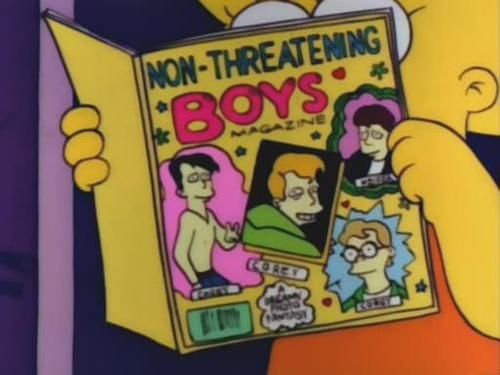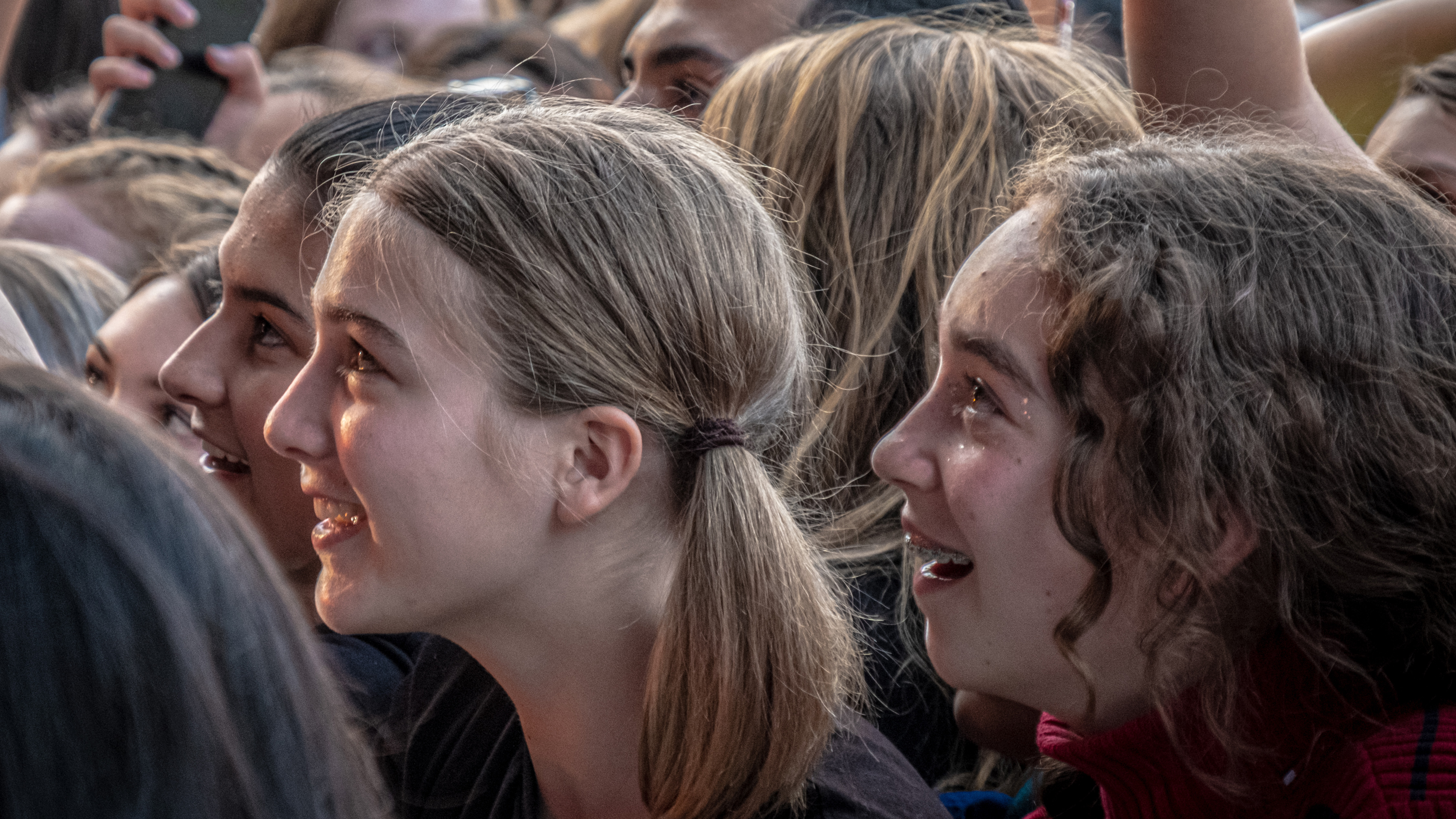Being a teenage girl is the absolute worst. If you’ve experienced this, you already know it. If you haven’t, here’s a brief overview: You’re tolerating the posturing machismo of teen boys (who are having their own hellish but different experience); you’re getting initiated into a sexual identity defined by the male gaze and the Madonna–whore dichotomy*; and you’re exhausted trying to impress colleges and earn spending money and look perfect.
Somehow in the midst of this you may find something that makes that makes you feel inspired and excited, as if your human experience is valid and you deserve to have art that depicts you and addresses your needs. And then, inevitably, adults, especially adult men, swoop in to inform you that your taste is terrible and your feelings are invalid because whatever it is you’ve found – whatever teen girls like – is unimportant and shallow. The cultural narrative is that if something matters to teen girls, it must not actually matter. If teen girls like boy bands or texting or vocal fry, those are the very hallmarks of vapidity.
This is sexist, it’s reductive, and it just plain sucks. And not just for the teen girls, who really don’t need your shit right now – for everyone. Because art that inverts the traditional male gaze, that centers teen girls’ interests and sensibilities, is radical and powerful like nothing else out there.
So let’s talk about what the teen female gaze is and why it matters.
*I can’t talk about Madonna–whore without linking to the music video where Taylor Swift plays both roles to a T.
The teen female gaze as a conduit of teen female desire
Just like the male gaze, the teen female gaze is sometimes simply about lust – tentative, adolescent lust. This is the moment in the female-driven teen movie when the camera lingers on the dreamy high school boy, and you feel the primal pull to write his name on your Trapper Keeper.
A few favorite examples of mine:
- In “Eighth Grade,” when Kayla’s crush Aiden enters the room, he literally moves in slow motion as heady synth music swells.
- When Starr’s boyfriend Chris appears on screen in “The Hate U Give,” you can practically feel the swooning.
- Pretty much everything in this perfect scene from “Hairspray” (2007), a perfect movie, qualifies. In particular we get this spectacularly gratuitous shot, from Tracy’s perspective as she spies on the boy’s bathroom and sings the words “french kissing”:

The teen female gaze is the most chastely horny thing in cinema. It’s fantastic – and not simply because girls deserve to have their own equivalent of Michael Bay drooling over Megan Fox in “Transformers” from behind the camera. The teen female gaze teaches young women that they have ownership of their sexuality. It teaches them that their desire matters.
Art that depicts teen girl lust is proof of the possibility of enthusiastic female consent. Flirting and dating and sex can provide them with joy and excitement. Girls can be active participants in their sexual interactions. Rather than being manipulated into intimacy, they can kiss that cute boy on their own terms. (There’s a reason Lisa Simpson is a frequent reader of Non-Threatening Boys Magazine.)

Sex can be something you want, not just something that happens to you. It might even be something you want with someone who isn’t male at all – a fact that narratives generated by men tend to forget.
The teen female gaze as a vessel of pride in teen female stories
There’s a difference between stories specifically for teen girls and stories about teen girls.
Stories about teen girls often smack of the limited perspectives of clueless adults. We all know that most “teen movies” show a caricatured version of high school. Very few of us bowed to a vicious, precisely defined social hierarchy in high school. Some of us might never even have attended a house party where precious heirlooms were destroyed. Of course, these movies are usually pretty harmless; we all know that’s not what it’s really like.
But the reality of the teen girl experience is mostly focused on friendship, and self-discovery, and learning to withstand mountains of stress. It’s also, often, a lot queerer than your typical popular fiction about teens. (“Booksmart”!) Stories that reflect this truth often resonate to a seismic extent that can baffle outside – male, adult – observers.
My favorite example is the musical “Wicked,” a massive success when it debuted in 2003 that is still thriving 16 years later. Its book is written by a woman – Winnie Holzman – and it shows.
The driving tension of the story is the complicated friendship/rivalry/philosophical differences between its two teen girl protagonists. The romance is secondary. (And by the way, the staging of the song “Dancing Through Life” is another pitch-perfect example of the desire-focused aspects of the teen female gaze.) The story is gentle and intimate, yet sardonic and political. It gives its teen girl characters’ beliefs weight and their actions lasting impact. Can you think of any other work of fiction where a political debate between two teen girls plays out on a national stage – albeit the stage of a fictional country – with repercussions that last for generations? Can you think of other works of fiction where two teen girls have a conversation about any meaningful topics, the way actual humans (and certainly teen girls) do? I can come up with a handful. There should be more.
(As an aside, while Gregory Maguire’s book on which the musical is based is astounding – elegantly wrought and achingly beautiful – we definitely can’t credit Maguire with the musical’s centering of the relationship between Elphaba and Glinda. The book is much more focused on Elphaba’s internal journey and political evolution. The musical deliberately shifted the narrative momentum.)
In a twist that is as comical as it is predictable, lots of adult male decision-makers in the entertainment industry took entirely the wrong lesson from “Wicked”’s success. They got the impression that the public was antsy for some kind of Oz Extended Universe of spin-off stories, which, of course, flopped. The actual lesson of “Wicked”’s success is that when you give teen girls stories for and about them – stories where their beliefs and feelings and actions matter – you earn their ardent, lifelong loyalty.
What teen girls can give back
When teen girls feel valued, the contributions they make can be enormous – both in the short term, and as they grow into adult women with careers. Moreover, teen girls can offer a unique, valuable perspective, and they often lack the cynicism of adults – especially adult women who have been worn down by decades of constant sexism and marginalization.
If you catch teen girls early, they’re optimistic enough to try upending systems of inequality and cruelty. We know this because incredible communities and achievements created by alliances of teen girls are all over the internet – if you know where to look. Teen girls have learned to sequester themselves from judgmental adults, but they’re still creating art and innovations to surprise and delight each other.
This excellent talk/presentation by Sacha Judd, “How the Tech Sector Could Move in One Direction,” is full of incredible examples of innovation and generosity from just one teen girl community – One Direction fandom. Archive of Our Own (commonly called AO3), a fan-created fanfiction archive, is another impressive case study. A majority-women community – including many young women who are made to feel unwelcome in traditional tech work – built AO3 and nurtured its community entirely on their own. Now, they maintain a useful, intuitive organizational system that should make major platforms like Instagram envious (if they’re aware it exists at all).
And that’s not even mentioning the fanfiction itself. As of this writing, AO3 contains nearly 5 million fan works – everything from short slice-of-life stories to sprawling epics that surpass the length (and arguably, the quality) of The Lord of the Rings. AO3 even features “podfics,” fan-created audiobook versions of fanfics, many of which span hours and have the audio quality of any professional production.
Teen girls saw your derision and made a vibrant, vast, wildly creative world of their own. Imagine what could happen if we all appreciated their talents – and centered their stories and perspectives in return.
Featured photo: The audience at a Billie Eilish concert, uploaded to Flickr by King County Parks Your Big Backyard.

